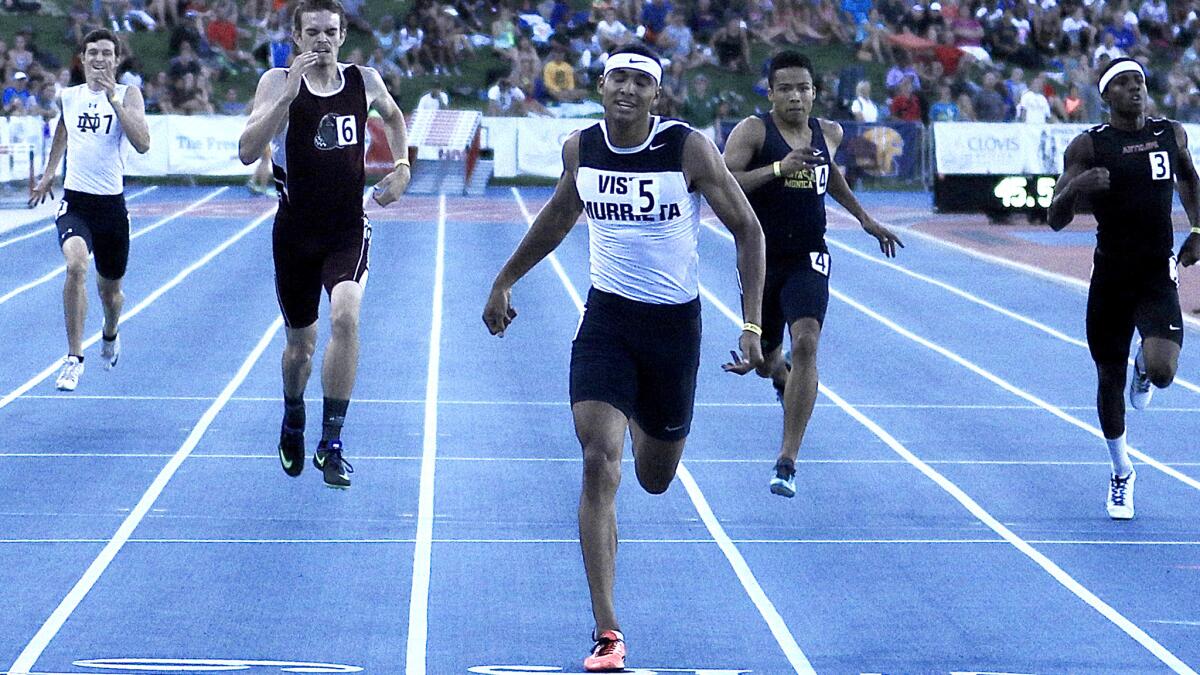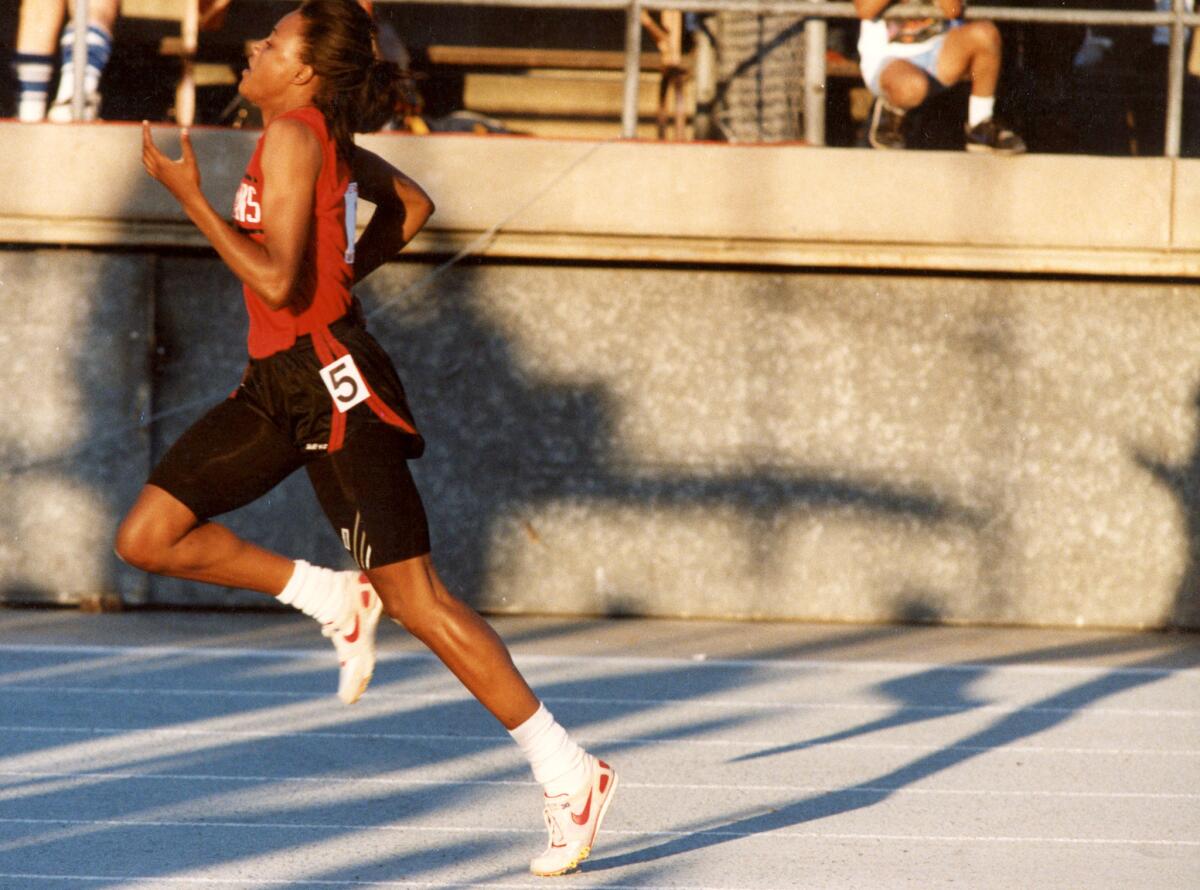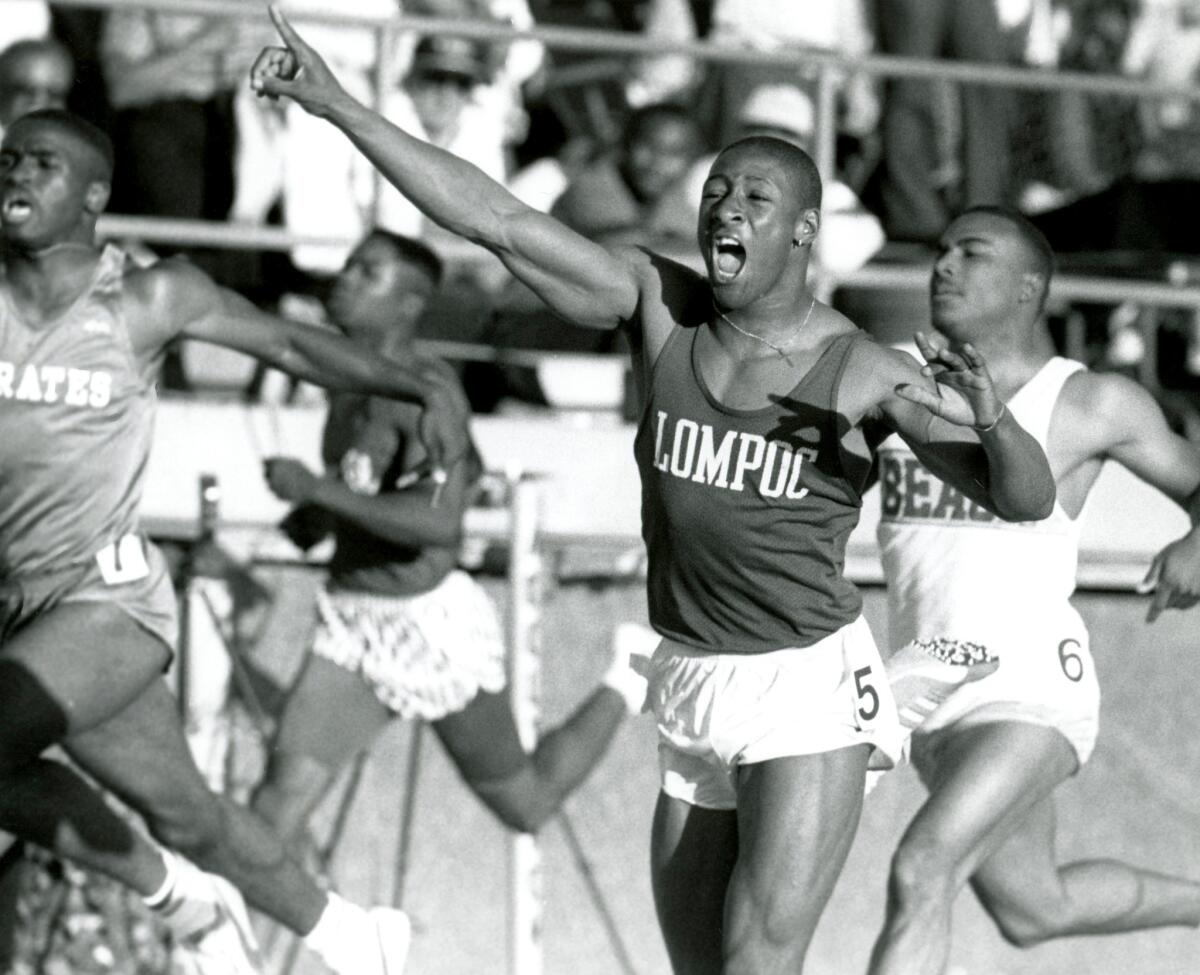100 years of the state track meet: from future Olympic heroes to Johnny Mathis, a tapestry of talent

Pete Rozelle was a young public relations man from Compton in 1948 when he attended the California Interscholastic Federationâs state track and field championships at the University of California.
The future commissioner of the NFL went to watch Compton High's Jerome Walters compete in the one-mile run. Walters, the champion in the 880 in 1947, finished second.
Rozelle went with friend and driver Al Franken. They saw the state meet at its best, a commencement exercise for some of the greatest athletes in the United States.
They witnessed Bob Mathias, a senior from Tulare, win the 120-yard high hurdles and the 180 low hurdles, and finish fourth in the shotput. Mathias went on to win gold in the decathlon in the 1948 Olympics in London and the 1952 Games in Helsinki, Finland.
Rozelle and Franken saw Los Angeles Jordan's George Brown win the state long jump. He would make the U.S. Olympic teams in 1948 and 1952.
They saw Ollie Matson, a sprinter from San Francisco Washington, finish third in the 100 and the 220. Matson won bronze and silver medals at the 1952 Games before becoming a star running back in the NFL.
"We had a nice time. We did not realize at the time the great things ahead for the athletes we saw," said Franken, who became a track and field promoter.
The CIF holds its 100th state meet June 1-2 at Veterans Memorial Stadium in Clovis. The first state meet was held in 1915. It was canceled for four years during World War II.
Signs acknowledging the milestone will be posted on stadium fences. Past teams, coaches and record-setting athletes will be honored and special guests will be invited.
If there is one high school event that celebrates the wealth of athletic talent in California, it is the state track and field meet. It might have the richest history of any state championship in any sport in America.
Nearly 80 men and women from California high schools have won Olympic medals in track, including Ventura Countyâs Marion Jones, Woodland Hills Taftâs Quincy Watts and L.A. Jordanâs Florence Griffth-Joyner. Two have won volleyball medals. Many more have made the U.S. Olympic team as well as teams from five other nations.

One of the most compelling parts of the competition is that it brings together athletes from all sizes of schools, public and private, instead of dividing them by divisions.
If there is one track and field event that symbolizes the excellence of the athletes in the state meet it's the 1970 long jump. San Mateo Serra's Lynn Swann leaped 24 feet 2 3/4 inches to beat Fresno Edison's Randy Williams by one-quarter of an inch. Pasadena Blair's James McAlister was third at 23-9 3/4.
Swann would go on to star at USC, become the most valuable player of Super Bowl X for the Pittsburgh Steelers, get selected to the Pro Football Hall of Fame and become athletic director at USC. Williams won the gold medal at the 1972 Olympics and the silver in 1976. McAlister had the world's leading long jump of 27-0 1/2 in 1973, still a school record at UCLA, where he also starred in football.
The meet celebrates the winners in the individual events more than the team champion at the end. The team scores rarely come down to the final relay. However, the 1960 meet is probably the most exciting on record. Premeet favorite Los Angeles Jordan lost star sprinter Hubie Watson to injury when he finished third in the 100.
Sophomore Lawrence Bonner came out of the stands â donning Watson's uniform and pole vaulter David Bludso's shoes â to run the second leg as Jordan finished fourth in the 1,600-meter relay for a 15-14 win over Oakland Castlemont.
The state meet is the pinnacle for many high school athletes.
"The state meet was the most important thing in my life when I was in high school," said Anaheim Loara graduate Ralph Serna, a three-time state meet distance runner, now 61. "I ran internationally as a teenager. I ran against the Russians. Those were strangers. At the state meet, I ran against people I knew inside and out. They knew me inside and out."
The meet has been supported by enthusiastic fans who have traveled as far north as Oroville and south to San Diego before it settled near Fresno in 2009.
Retired USC coach Ron Allice said the state meet is âa pilgrimageâ for fans. âThatâs a must-see event on the calendar.â
Pasadena's Charley Paddock was the first state meet performer to go on to Olympic glory. He won the 100-yard dash in 1916. He won two gold medals and a silver at the 1920 Olympics and participated in two more Games.

Other prep track stars have gone to college track and football, the NFL and Pro Football Hall of Fame, the NBA, MLB, boxing, pro wrestling, pro soccer, politics, musical stardom, the Broadway stage, television drama, high school coaching and one extraordinary war hero.
Torrance's Louis Zamperini, the winner of the mile in 1934, ran in the 1936 Olympics while at USC and is best remembered for his heroism as a prisoner of war of the Japanese during World War II. He was awarded the Distinguished Flying Cross and a Purple Heart.
Johnny Mathis of San Francisco Washington tied for sixth in the high jump in 1952. He has been inducted into the Grammy Hall of Fame during a recording career that includes many gold and platinum albums.
Hanford's Cornelius Warmerdam (pole vault), Compton Centennial's Charlie Dumas (high jump), Santa Monica's Parry O'Brien (shotput), Covina Edgewood's Mike Powell (long jump) and L.A. Jordanâs Kevin Young (400 hurdles) and Griffith-Joyner (sprints) set world records. The marks by Young, Powell and Griffith-Joyner still stand.
Berkeley's Robert Culp cleared 12-3 to tie for second in the pole vault in 1947. He went on to an acting career, most prominently in the "I Spy" television series.
Newport Harbor's Misty May-Treanor, the runner-up in the high jump in 1993, became a three-time Olympic gold medalist in beach volleyball.
Newport Harbor's Jim Neidhart won the shotput in 1973, competed for UCLA, gave pro football a try and became a professional wrestler with the nickname "The Anvil."
Riverside Poly's Bobby Bonds won the long jump in 1965 and went on to a 14-year career in the majors.
L.A. Washington's Hugh McElhenny won the high hurdles, low hurdles and long jump at the 1947 meet. He would go on to a career in the NFL. He would be joined in the San Francisco 49ers million-dollar backfield by Pittsburg's John Henry Johnson, who won the discus in 1949.

Some state meet participants became renowned for their support of social causes.
Tommie Smith, the 1963 state winner in the 440, won the gold medal in the 200 meters at the 1968 Olympics and everlasting fame for his black power salute alongside John Carlos during the national anthem on the victory stand.
"Most people know [Smith] from his impactful statement he made on the Olympic podium in the 1968 Games," said Michael Norman, a USC sophomore who won consecutive 200 and 400 state titles recently. "Having my name on the same list as Tommie Smith demonstrates the rich history of California's state meet."
Rafer Johnson, from Kingsburg in the San Joaquin Valley, won the 120 high hurdles at the 1954 state meet. He was Sports Illustratedâs sportsman of the year for 1958 and Olympic decathlon champion in 1960. He lit the Olympic torch at the opening ceremonies for the 1984 Games. He helped capture Sirhan Sirhan, Robert F. Kennedy's assassin, at the scene of the crime in 1968. And Johnson has been an advocate for the Special Olympics.
The 1962 meet is an example of the eventâs connection to future glory. L.A. Fremont's Willie Crawford handed the baton to anchorman Richard Stebbins, who brought his team home second in the 880 relay. Stebbins won gold in the Olympic 400-meter relay in 1964. Crawford played for the Dodgers in the 1965 World Series.

While professional and college track have declined in popularity, the high school level of the sport remains popular. Fire marshals had to close the gates at the 1981 meet at Cerritos College because the stadium was full. Since the meet was moved to Clovis in 2009, the meet has averaged nearly 16,000 spectators for the two days.
The state meet is ever changing, adding girlsâ competition in 1974 and shifting the distance from yards to meters. The 180-yard low hurdles became the 300-meter intermediate hurdles. The 200 is run around one curve now and the 400 two turns. The 220 used to be on a straightaway and the 440 around one curve. Dirt tracks have given way to swift, artificial surfaces. Saw dust pits have been replaced by foam. Poles used by vaulters have progressed from bamboo to metal to fiberglass.
The state meet became a proving ground for females such as Olympic gold medalists Gail Devers, Joanna Hayes and Allyson Felix. The latter, a graduate of L.A. Baptist in North Hills, is the most decorated American woman in track history.
Another change in the state meet has been the decline in the participation of football players. Many are busy with weight lifting, spring practice and seven-on-seven leagues.
Before there was an NFL combine, San Diego Chargers general manager Johnny Sanders attended the state meet during the 1970s. Sanders, once a coach at North Hollywood High, would watch the sprints for potential running backs and receivers, and the shotput and discus for linemen prospects.
The 100th state meet will be the 50th for North Hollywood graduate Hal Harkness, who will be the rules interpreter. Harkness, 79, finished fourth in the mile during his first state meet at Chico State in 1956. Harkness has been a coach, an official and meet director at 49 subsequent state meets.
Harkness said the state meet prospers because it has never been touched by scandal unlike higher levels of the sport.
"It's pure athletics," Harkness said. "I can't think of any incident before or after the meet that has a negative image. It's two days of good competition."
Jerry Soifer is a freelance journalist who has worked at the Riverside Press-Enterprise and Los Angeles Times.
Get our high school sports newsletter
Prep Rally is devoted to the SoCal high school sports experience, bringing you scores, stories and a behind-the-scenes look at what makes prep sports so popular.
You may occasionally receive promotional content from the Los Angeles Times.



